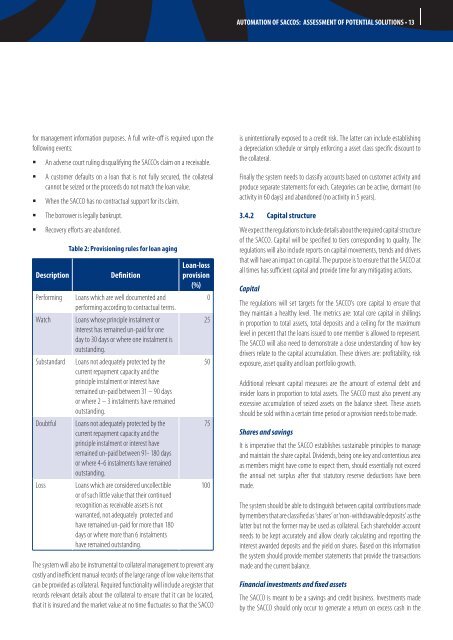Automation of SACCOs - FSD Kenya
Automation of SACCOs - FSD Kenya
Automation of SACCOs - FSD Kenya
You also want an ePaper? Increase the reach of your titles
YUMPU automatically turns print PDFs into web optimized ePapers that Google loves.
for management information purposes. A full write-<strong>of</strong>f is required upon the<br />
following events:<br />
An adverse court ruling disqualifying the <strong>SACCOs</strong> claim on a receivable.<br />
A customer defaults on a loan that is not fully secured, the collateral<br />
cannot be seized or the proceeds do not match the loan value.<br />
When the SACCO has no contractual support for its claim.<br />
The borrower is legally bankrupt.<br />
Recovery efforts are abandoned.<br />
Table 2: Provisioning rules for loan aging<br />
Description Definition<br />
Performing Loans which are well documented and<br />
performing according to contractual terms.<br />
Watch Loans whose principle instalment or<br />
interest has remained un-paid for one<br />
day to 30 days or where one instalment is<br />
outstanding.<br />
Substandard Loans not adequately protected by the<br />
current repayment capacity and the<br />
principle instalment or interest have<br />
remained un-paid between 31 – 90 days<br />
or where 2 – 3 instalments have remained<br />
outstanding.<br />
Doubtful Loans not adequately protected by the<br />
current repayment capacity and the<br />
principle instalment or interest have<br />
remained un-paid between 91- 180 days<br />
or where 4-6 instalments have remained<br />
outstanding.<br />
Loss Loans which are considered uncollectible<br />
or <strong>of</strong> such little value that their continued<br />
recognition as receivable assets is not<br />
warranted, not adequately protected and<br />
have remained un-paid for more than 180<br />
days or where more than 6 instalments<br />
have remained outstanding.<br />
Loan-loss<br />
provision<br />
(%)<br />
0<br />
The system will also be instrumental to collateral management to prevent any<br />
costly and inefficient manual records <strong>of</strong> the large range <strong>of</strong> low value items that<br />
can be provided as collateral. Required functionality will include a register that<br />
records relevant details about the collateral to ensure that it can be located,<br />
that it is insured and the market value at no time fluctuates so that the SACCO<br />
25<br />
50<br />
75<br />
100<br />
AUTOMATION OF SACCOS: ASSESSMENT OF POTENTIAL SOLUTIONS • 13<br />
is unintentionally exposed to a credit risk. The latter can include establishing<br />
a depreciation schedule or simply enforcing a asset class specific discount to<br />
the collateral.<br />
Finally the system needs to classify accounts based on customer activity and<br />
produce separate statements for each. Categories can be active, dormant (no<br />
activity in 60 days) and abandoned (no activity in 5 years).<br />
3.4.2 Capital structure<br />
We expect the regulations to include details about the required capital structure<br />
<strong>of</strong> the SACCO. Capital will be specified to tiers corresponding to quality. The<br />
regulations will also include reports on capital movements, trends and drivers<br />
that will have an impact on capital. The purpose is to ensure that the SACCO at<br />
all times has sufficient capital and provide time for any mitigating actions.<br />
Capital<br />
The regulations will set targets for the SACCO’s core capital to ensure that<br />
they maintain a healthy level. The metrics are: total core capital in shillings<br />
in proportion to total assets, total deposits and a ceiling for the maximum<br />
level in percent that the loans issued to one member is allowed to represent.<br />
The SACCO will also need to demonstrate a close understanding <strong>of</strong> how key<br />
drivers relate to the capital accumulation. These drivers are: pr<strong>of</strong>itability, risk<br />
exposure, asset quality and loan portfolio growth.<br />
Additional relevant capital measures are the amount <strong>of</strong> external debt and<br />
insider loans in proportion to total assets. The SACCO must also prevent any<br />
excessive accumulation <strong>of</strong> seized assets on the balance sheet. These assets<br />
should be sold within a certain time period or a provision needs to be made.<br />
Shares and savings<br />
It is imperative that the SACCO establishes sustainable principles to manage<br />
and maintain the share capital. Dividends, being one key and contentious area<br />
as members might have come to expect them, should essentially not exceed<br />
the annual net surplus after that statutory reserve deductions have been<br />
made.<br />
The system should be able to distinguish between capital contributions made<br />
by members that are classified as ‘shares’ or ‘non-withdrawable deposits’ as the<br />
latter but not the former may be used as collateral. Each shareholder account<br />
needs to be kept accurately and allow clearly calculating and reporting the<br />
interest awarded deposits and the yield on shares. Based on this information<br />
the system should provide member statements that provide the transactions<br />
made and the current balance.<br />
Financial investments and fixed assets<br />
The SACCO is meant to be a savings and credit business. Investments made<br />
by the SACCO should only occur to generate a return on excess cash in the
















